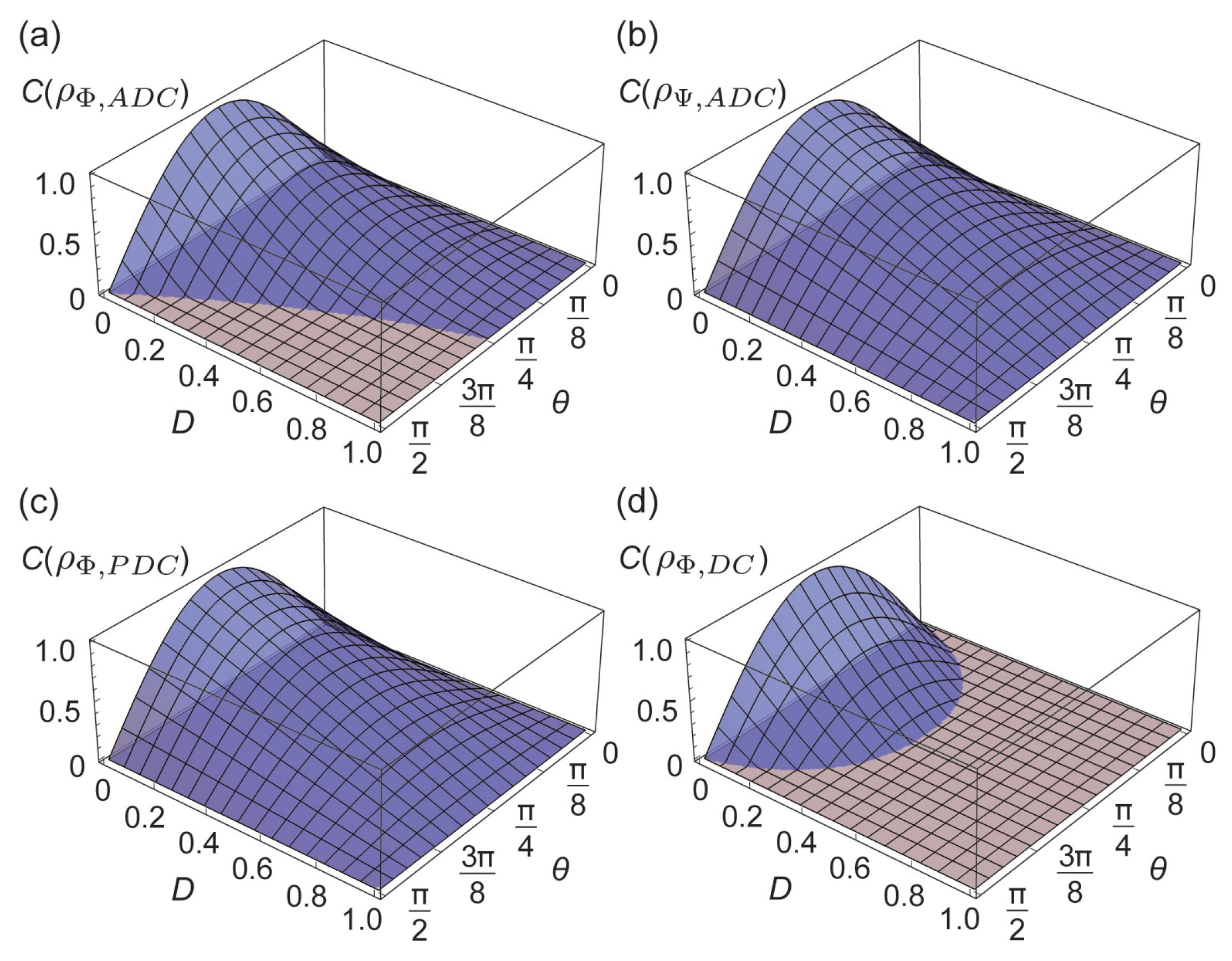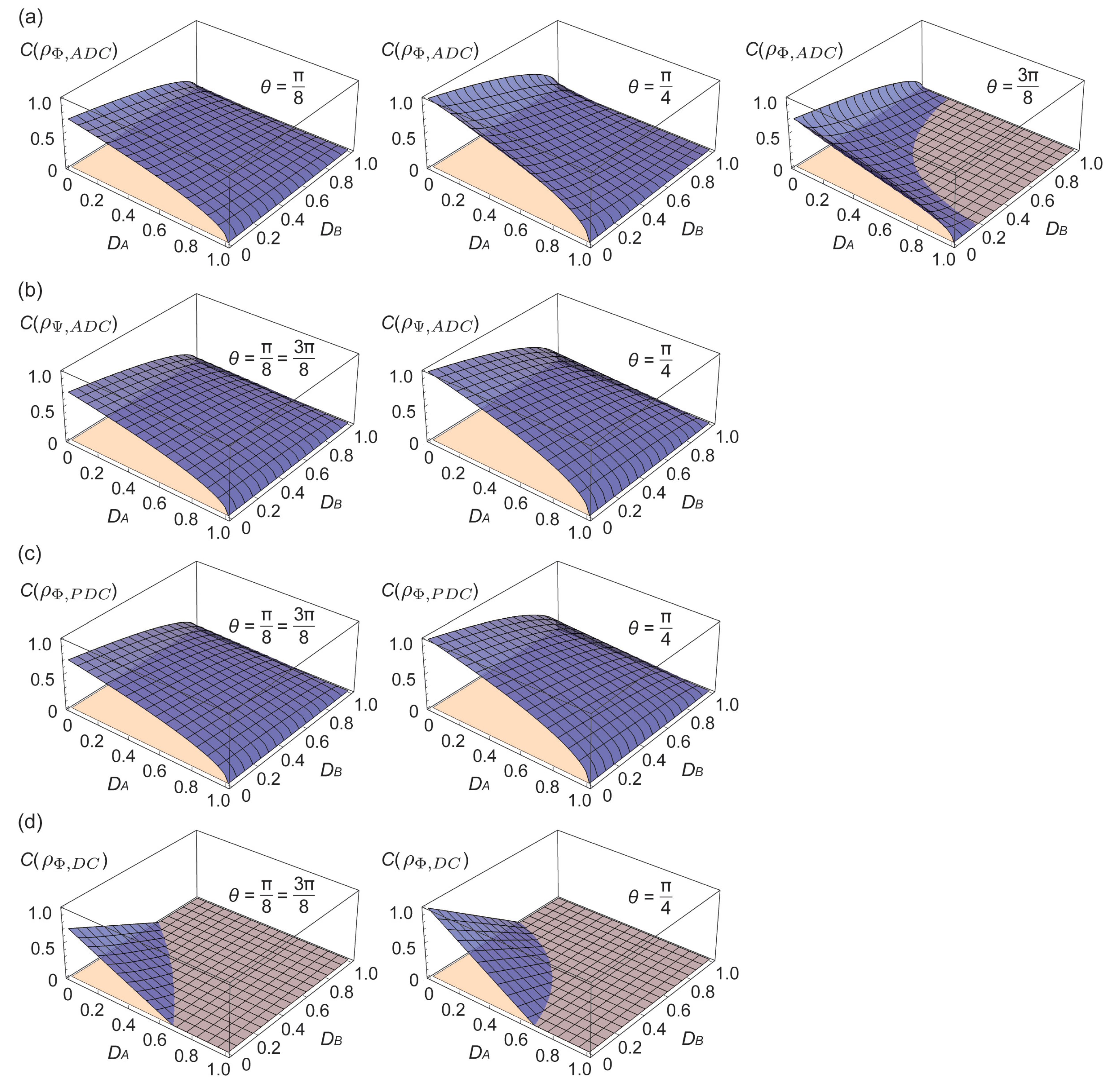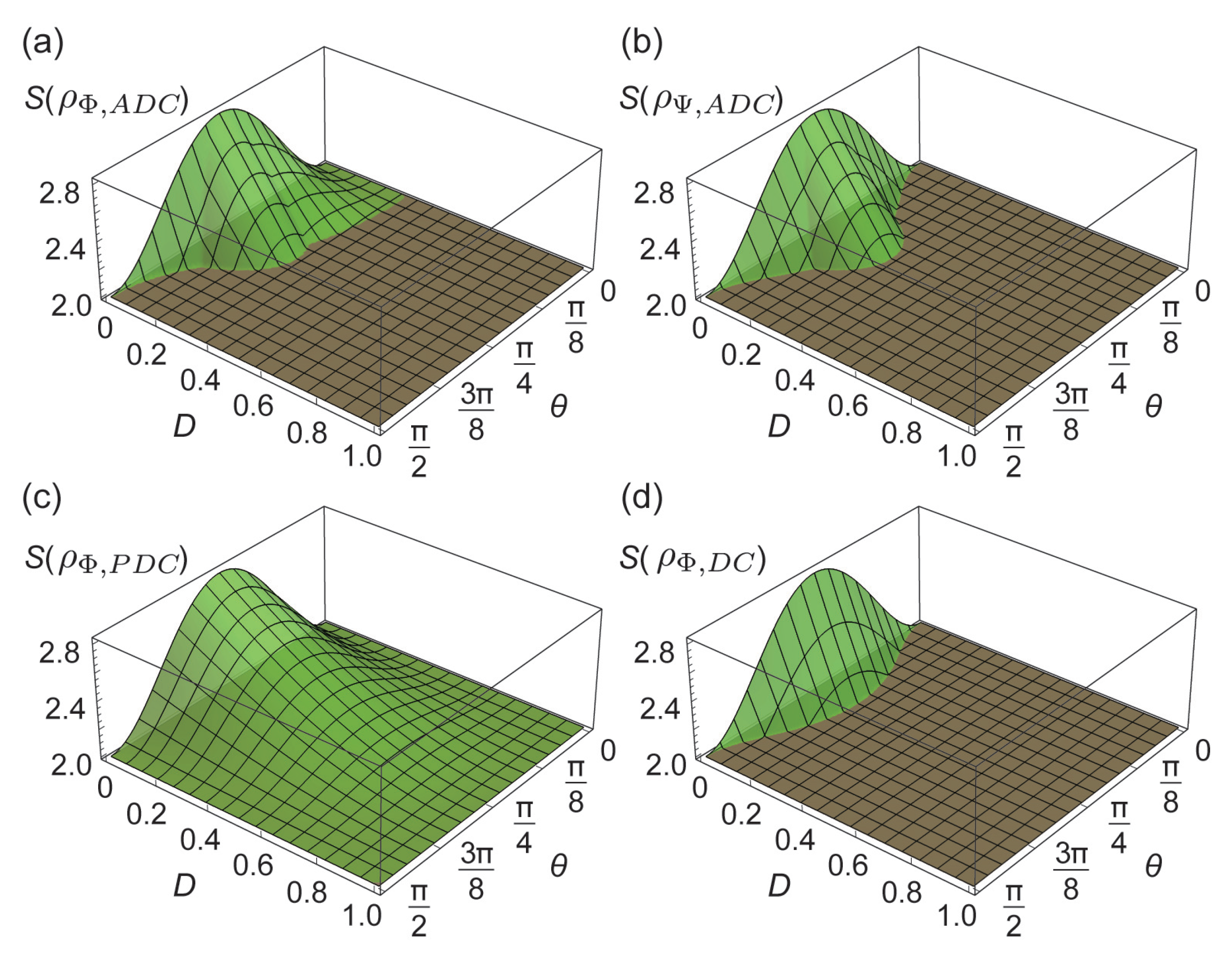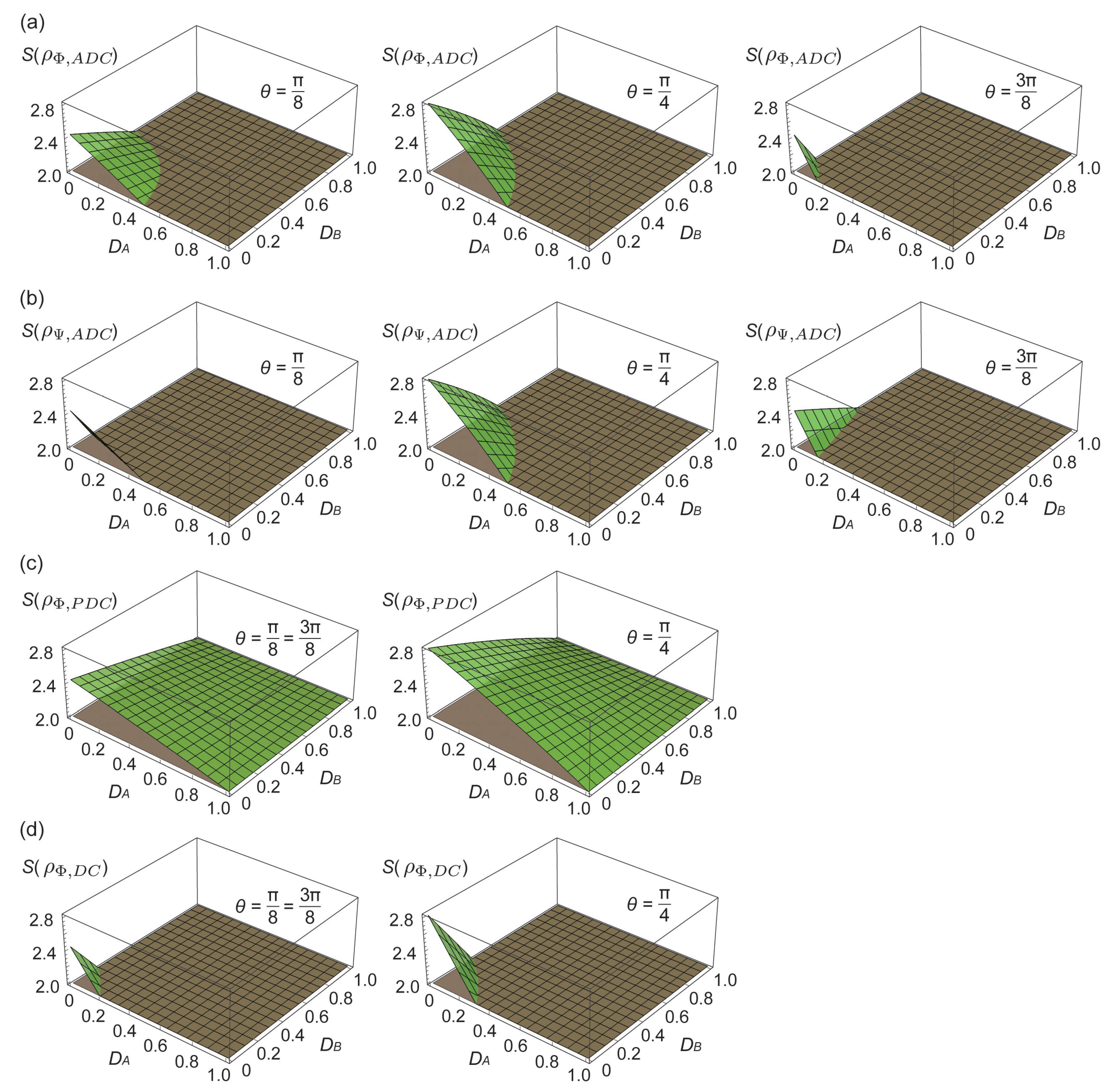Decoherence-Induced Sudden Death of Entanglement and Bell Nonlocality
Abstract
:1. Introduction
2. Materials and Methods
2.1. Bipartite Entangled State under Decoherence
2.1.1. Amplitude Damping Channel
2.1.2. Phase Damping Channel
2.1.3. Depolarizing Channel
2.2. Entanglement Sudden Death
2.3. Bell Nonlocality Sudden Death
3. Results
3.1. Entanglement
3.2. Bell Nonlocality
4. Discussion
Author Contributions
Funding
Institutional Review Board Statement
Informed Consent Statement
Data Availability Statement
Conflicts of Interest
References
- Horodecki, R.; Horodecki, P.; Horodecki, M.; Horodecki, K. Quantum entanglement. Rev. Mod. Phys. 2009, 81, 865–942. [Google Scholar] [CrossRef] [Green Version]
- Gisin, N.; Thew, R. Quantum communication. Nat. Photonics 2007, 1, 165. [Google Scholar] [CrossRef] [Green Version]
- Ursin, R.; Tiefenbacher, F.; Schmitt-Manderbach, T.; Weier, H.; Scheidl, T.; Lindenthal, M.; Blauensteiner, B.; Jennewein, T.; Perdigues, J.; Trojek, P.; et al. Entanglement-based quantum communication over 144 km. Nat. Phys. 2007, 3, 481. [Google Scholar] [CrossRef] [Green Version]
- Bennett, C.H.; Brassard, G.; Crépeau, C.; Jozsa, R.; Peres, A.; Wootters, W.K. Teleporting an unknown quantum state via dual classical and Einstein–Podolsky-Rosen channels. Phys. Rev. Lett. 1993, 70, 1895. [Google Scholar] [CrossRef] [PubMed] [Green Version]
- Bouwmeester, D.; Pan, J.-W.; Mattle, K.; Eibl, M.; Weinfurter, H.; Zeilinger, A. Experimental quantum teleportation. Nature 1997, 390, 575. [Google Scholar] [CrossRef] [Green Version]
- Kim, Y.-H.; Kulik, S.P.; Shih, Y. Quantum teleportation of a polarization state with a complete Bell state measurement. Phys. Rev. Lett. 2001, 86, 1370. [Google Scholar] [CrossRef] [PubMed] [Green Version]
- Kok, P.; Munro, W.J.; Nemoto, K.; Ralph, T.C.; Dowling, J.P.; Milburn, G.J. Linear optical quantum computing with photonic qubits. Rev. Mod. Phys. 2007, 79, 135. [Google Scholar] [CrossRef] [Green Version]
- Giovannetti, V.; Lloyd, S.; Maccone, L. Advances in quantum metrology. Nat. Photonics 2011, 5, 222. [Google Scholar] [CrossRef]
- Brunner, N.; Cavalcanti, D.; Pironio, S.; Scarani, V.; Wehner, S. Bell nonlocality. Rev. Mod. Phys. 2014, 86, 419–478. [Google Scholar] [CrossRef] [Green Version]
- Ekert, A.K. Quantum cryptography based on Bell’s theorem. Phys. Rev. Lett. 1991, 67, 661–663. [Google Scholar] [CrossRef] [Green Version]
- Barrett, J.; Hardy, L.; Kent, A. No Signaling and Quantum Key Distribution. Phys. Rev. Lett. 2005, 95, 010503. [Google Scholar] [CrossRef] [PubMed] [Green Version]
- Acín, A.; Brunner, N.; Gisin, N.; Massar, S.; Pironio, S.; Scarani, V. Device-Independent Security of Quantum Cryptography against Collective Attacks. Phys. Rev. Lett. 2007, 98, 230501. [Google Scholar] [CrossRef] [PubMed] [Green Version]
- Vazirani, U.; Vidick, T. Fully Device-Independent Quantum Key Distribution. Phys. Rev. Lett. 2014, 113, 140501. [Google Scholar] [CrossRef] [PubMed] [Green Version]
- Zurek, W.H. Decoherence, einselection, and the quantum origins of the classical. Rev. Mod. Phys. 2003, 75, 715–775. [Google Scholar] [CrossRef] [Green Version]
- Bennett, C.H.; Brassard, G.; Popescu, S.; Schumacher, B.; Smolin, J.A.; Wootters, W.K. Purification of noisy entanglement and faithful teleportation via noisy channels. Phys. Rev. Lett. 1997, 76, 722–725. [Google Scholar] [CrossRef] [PubMed] [Green Version]
- Pan, J.-W.; Gasparoni, S.; Ursin, R.; Weihs, G.; Zeilinger, A. Experimental entanglement purification of arbitrary unknown states. Nature 2003, 423, 417–422. [Google Scholar] [CrossRef] [PubMed]
- Yamamoto, T.; Koashi, M.; Özdemir, S.K.; Imoto, N. Experimental extraction of an entangled photon pair from two identically decohered pairs. Nature 2003, 421, 343–346. [Google Scholar] [CrossRef]
- Bennett, C.H.; Bernstein, H.J.; Popescu, S.; Schumacher, B. Concentrating partial entanglement by local operations. Phys. Rev. A 1996, 53, 2046–2052. [Google Scholar] [CrossRef] [Green Version]
- Zhao, Z.; Yang, T.; Chen, Y.-A.; Zhang, A.-N.; Pan, J.-W. Experimental realization of entanglement concentration and a quantum repeater. Phys. Rev. Lett. 2003, 90, 207901. [Google Scholar] [CrossRef] [Green Version]
- Yu, T.; Eberly, J.H. Finite-Time Disentanglement via Spontaneous Emission. Phys. Rev. Lett. 2004, 93, 140404. [Google Scholar] [CrossRef] [Green Version]
- Jaeger, G.; Ann, K. Local basis-dependent noise-induced Bell-nonlocality sudden death in tripartite systems. Phys. Lett. A 2008, 372, 2212–2216. [Google Scholar] [CrossRef]
- Yu, T.; Eberly, J.H. Quantum Open System Theory: Bipartite Aspects. Phys. Rev. Lett. 2006, 97, 140403. [Google Scholar] [CrossRef] [PubMed] [Green Version]
- Almeida, M.P.; de Melo, F.; Hor-Meyll, M.; Salles, A.; Walborn, S.P.; Souto Ribeiro, P.H.; Davidovich, L. Environment-induced sudden death of entanglement. Science 2007, 316, 579–582. [Google Scholar] [CrossRef] [PubMed] [Green Version]
- Salles, A.; de Melo, F.; Almeida, M.P.; Hor-Meyll, M.; Walborn, S.P.; Souto Ribeiro, P.H.; Davidovich, L. Experimental investigation of the dynamics of entanglement: Sudden death, complementarity, and continuous monitoring of the environment. Phys. Rev. A 2008, 78, 022322. [Google Scholar] [CrossRef] [Green Version]
- Yu, T.; Eberly, J.H. Sudden death of entanglement. Science 2009, 323, 598–601. [Google Scholar] [CrossRef] [PubMed] [Green Version]
- Sun, W.-Y.; Wang, D.; Shi, J.-D.; Ye, L. Exploration quantum steering, nonlocality and entanglement of two-qubit X-state in structured reservoirs. Sci. Rep. 2017, 7, 39651. [Google Scholar] [CrossRef] [Green Version]
- Pramanik, T.; Cho, Y.-W.; Han, S.-W.; Lee, S.-Y.; Moon, S.; Kim, Y.-S. Nonlocal quantum correlation under amplitude damping decoherence. Phys. Rev. A 2019, 100, 042311. [Google Scholar] [CrossRef] [Green Version]
- Kraus, K. States, Effect, and Operations: Fundamental Notions in Quantum Theory; Springer: Berlin, Germany, 1983. [Google Scholar]
- Wootters, W.K. Entanglement of formation of an arbitrary state of two qubits. Phys. Rev. Lett. 1998, 80, 2245–2248. [Google Scholar] [CrossRef] [Green Version]
- Gisin, N.; Peres, A. Maximal violation of Bell’s inequality for arbitrarily large spin. Phys. Lett. A 1992, 162, 15–17. [Google Scholar] [CrossRef]
- Horodecki, R.; Horodecki, P.; Horodecki, M. Violating Bell inequality by mixed spin-12 state: Necessary and sufficient condition. Phys. Lett. A 1995, 200, 340–344. [Google Scholar] [CrossRef]




| Decoherence | Kraus Operators |
|---|---|
| Amplitude damping | |
| Phase damping | |
| Depolarizing | |
| ESD | BNSD | |||||
|---|---|---|---|---|---|---|
| Amplitude Damping | Phase Damping | Depolarizing | Amplitude Damping | Phase Damping | Depolarizing | |
| × | × | ◯ | ◯ | × | ◯ | |
| ◯ for | × | ◯ | ◯ | × | ◯ | |
| × for | ||||||
Publisher’s Note: MDPI stays neutral with regard to jurisdictional claims in published maps and institutional affiliations. |
© 2022 by the authors. Licensee MDPI, Basel, Switzerland. This article is an open access article distributed under the terms and conditions of the Creative Commons Attribution (CC BY) license (https://creativecommons.org/licenses/by/4.0/).
Share and Cite
Im, D.-G.; Kim, Y.-H. Decoherence-Induced Sudden Death of Entanglement and Bell Nonlocality. Photonics 2022, 9, 58. https://doi.org/10.3390/photonics9020058
Im D-G, Kim Y-H. Decoherence-Induced Sudden Death of Entanglement and Bell Nonlocality. Photonics. 2022; 9(2):58. https://doi.org/10.3390/photonics9020058
Chicago/Turabian StyleIm, Dong-Gil, and Yoon-Ho Kim. 2022. "Decoherence-Induced Sudden Death of Entanglement and Bell Nonlocality" Photonics 9, no. 2: 58. https://doi.org/10.3390/photonics9020058
APA StyleIm, D.-G., & Kim, Y.-H. (2022). Decoherence-Induced Sudden Death of Entanglement and Bell Nonlocality. Photonics, 9(2), 58. https://doi.org/10.3390/photonics9020058





